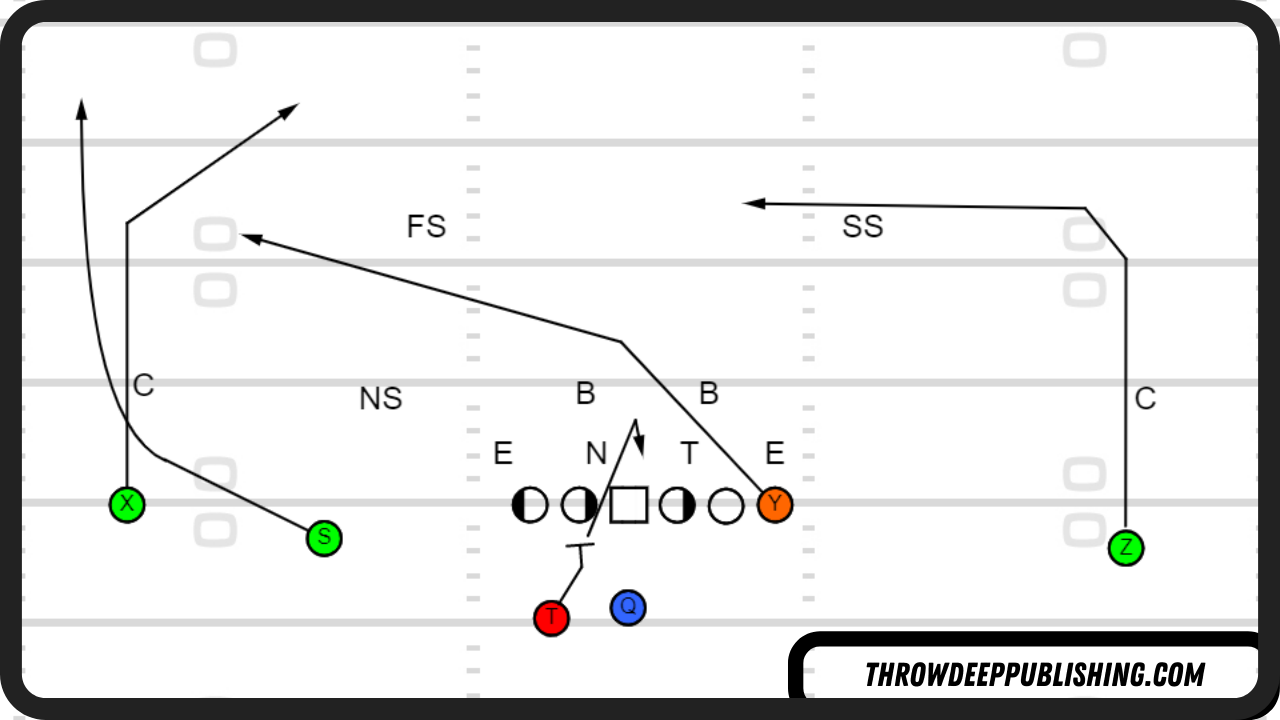
Overview & Purpose of the Concept
This concept gets some of your best skill players on the move looking to create big plays down the football field. The core of this concept is the post, crosser and RB stretching the flat to the boundary. On the backside, teams are able to tag a variety of routes/combinations that give the QB decision-making power within his progression, such as the smash concept.
This is another great horizontal pass concept that gets skill players on the move across the middle of the field, and adds another layer to the passing attack, similar to the Shallow Cross concept.
Coverages it Does Well Against
Man Coverage- The offense has two routes in the post, and crosser running away from man coverage. This creates a great opportunity to get it to a skill player on the move.
Cover 4 - Defenses tend to include their boundary free safety in the fun fit in cover 4. This creates the potential for the post-route runner to win over the top of the defense.
Coverages it Doesn’t Do Well Against
Cover 3 - Take this with a grain of salt, as this concept is one that can be called against all defenses. However, 1-high defenses have what is referred to as a “post safety”, who is both responsible for, and already occupying the middle of the field pre and post snap.
With the post as the primary throw on this play, coordinators will look for other routes/combinations to push the ball downfield against 1-high defenses, such as the Yankee Concept.
Route Coaching Points vs Man and Zone

Coaching Points vs Man Coverage
TE (Y) - Release inside of the Sam LB, and over the Mike LB. Landmark is 18-22 yards.
FB (Right Side)- Check pass protection responsibilities. Release wide on flare.
TB (Left Side)- Run check-down off of Will LB. Vs man, stay on the move on out cut.
X Receiver - Post Route over top of the free safety.
Z Receiver- 15-yard speed cut dig, stay on the move.
Coaching Points vs Zone Coverage
TE (Y) - Release inside of the Sam LB, and over the Mike LB. Landmark is 18-22 yards.
FB (Right Side)- Check pass protection responsibilities. Release wide on flare.
TB (Left Side)- Run check-down off of Will LB. Vs zone, sit route down.
X Receiver - Post Route over top of the free safety.
Z Receiver- 15-yard speed cut dig, stay on the move, tempo in open voids.
Quarterback Coaching Points and Progression
In a base Y-Cross read, the QB’s progression can remain the same regardless of the number of safeties/coverage of the defense. In terms of throwing the crossing route, the QB should be prepared to throw it both on a line, or with some touch over LB level depending on how the defense plays it.
Progression
1) Post
2) Deep Crosser
3) RB Check-down OR Dig

Referring to the diagram above, Y-Cross creates two natural high-low reads against a 2-high defense. Post-snap, the QB should identify whether the FS freezes his feet or plays downhill, in this case, the QB should look to take the home-run shot to the post runner.
If the FS honors the X WR on the post, the QB should transition to high-low the Will LB. If the Will LB fails to gain significant depth, the QB should look to hit the crosser coming across the field. If the Will sinks, taking away the crosser, the RB on his check-down, or the dig from the backside become the 3rd option.
Variations
Variation 1- A great variation that looks to push the ball downfield, the QB can read the post-wheel combination first as he begins his progression. As he gives this time, the crosser will come right into his line vision as he moves off his primary read.
The remaining core remains the same, with both the RB check-down and backside dig becoming a 3rd option on this play.

As mentioned before, personnel groupings play a big role in deploying this concept. Have a great slot receiver that you want to utilize? This is a great way to do so while keeping the integrity of the play close to the exact same for your QB as he goes through his read.
Variation 2- The progression for the quarterback remains the same into the boundary. This curl-flat tag is a great option for the quarterback to look to vs 1-high defense, or to transition to if he doesn’t like what he sees with his post/cross/flat combination.

The better your quarterback is at scanning defenses, the more you can look to vary the options he has on this play. This tag to the field requires a strong-armed QB as well when it comes to throwing the curl from the opposite hash. All things considered, variations such as this are a great way to enhance and further offensive structure.
Want more?
Check out our collection of some of the best football coaching books you'll find anywhere.
